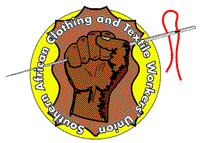
The World Federation of Trade Unions (WFTU) is an international federation of trade unions established in 1945. Founded in the immediate aftermath of World War Two, the organization built on the pre-war legacy of the International Federation of Trade Unions as a single structure for trade unions world-wide, following the World Trade Union Conference in London, United Kingdom.
Quota Elimination is an initiative to eliminate the use of quotas in all textile and clothing trade between nations which are members of the World Trade Organization (WTO). Doing so was one of the key commitments undertaken at the WTO Uruguay Round in 1994 to retire the Multi Fibre Arrangement. The ATC, that is the WTO Agreement on Textile and Clothing, is the regulation governing textile and clothing and implements this commitment.

The Southern African Clothing and Textile Workers' Union (SACTWU) is the biggest union in the South African clothing, textile, footwear and leather industry, with more than 100 000 members. It negotiates wages for the vast majority of workers in these industries in South Africa, with the collective bargaining agreements covering over 150 000 workers.
The International Federation Textile-Clothing (IFTC/FITH) was an International Trade Federation of the World Confederation of Labour (WCL).
The study of the history of clothing and textiles traces the development, use, and availability of clothing and textiles over human history. Clothing and textiles reflect the materials and technologies available in different civilizations at different times. The variety and distribution of clothing and textiles within a society reveal social customs and culture.
The United Hatters, Cap and Millinery Workers International Union (1934–1983), also known by acronyms including UHCMW, U.H.C. & M.W.I.U. and UHC & MWIU, was a 20th-century American labor union.
The Trade Union International of Textile, Leather and Fur Workers Unions was a trade union international affiliated with the World Federation of Trade Unions.
The General Union of Loom Overlookers (GULO) was a trade union representing junior supervisors in textile manufacturing in the United Kingdom. While most members were based in Lancashire, it also had members in Yorkshire, East Anglia and Essex.
The Northern Counties Textile Trades Federation was a trade union federation in northern England.
The International Clothing Workers' Federation (IGWF) was a global union federation representing workers involved in making and repairing clothes.
The Leather Union was a West German trade union representing workers in shoemaking, tanning, saddlery, and other work related to leather.
Karl Buschmann was a German trade union leader.
Berthold Keller was a German trade union leader.
The Danish Clothing Workers' Union was a trade union representing people in the garment industry in Denmark.
Édouard Aubert was a French trade union leader.

The German Clothing Workers' Union was a trade union representing people involved in making clothing in Germany.
The Industrial Union of Textiles, Clothing and Leather was a trade union representing workers in the textile, clothing, leather, and tobacco industries in East Germany.

The General Industrial Union of Textiles and Clothing, also known as De Eendracht, was a trade union representing workers in the textile and garment industries in the Netherlands.
Tonnis van der Heeg was a Dutch trade unionist, politician, and resistance activist.
The Amalgamated Clothing and Textile Workers' Union of South Africa (ACTWUSA) was a trade union representing workers in the garment and fabric industries in South Africa.



